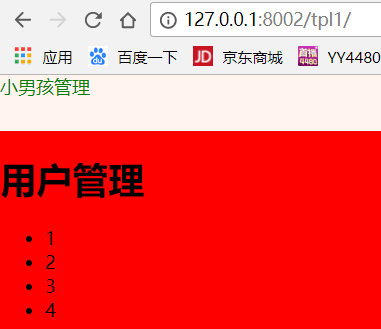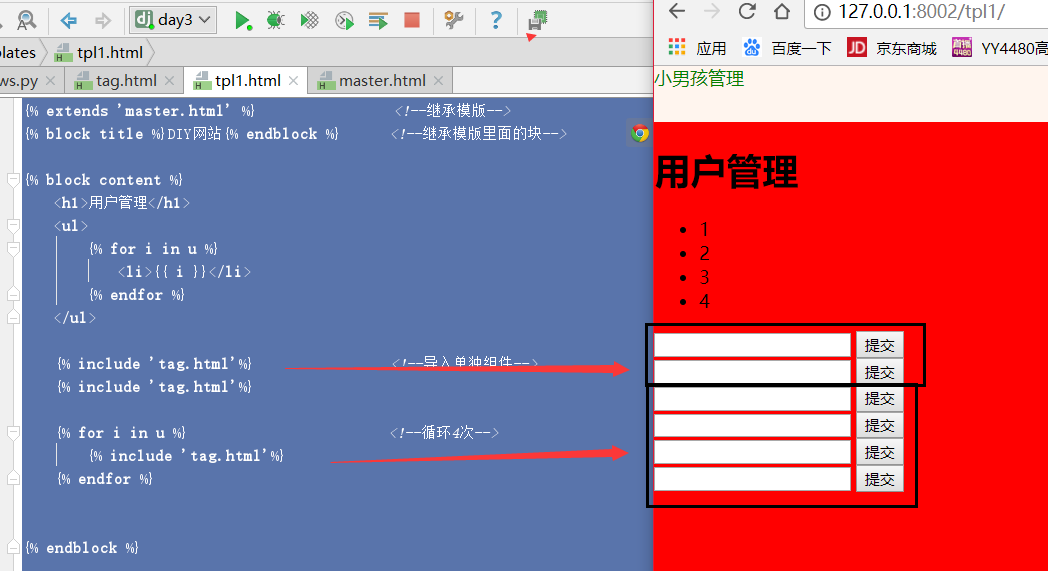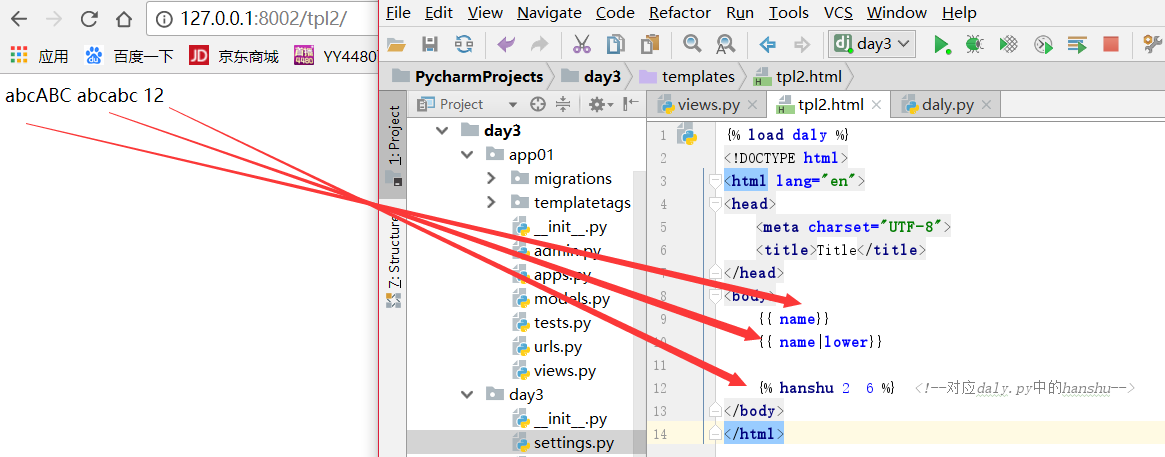继承
① extends用法:只继承一个模版

<!DOCTYPE html> <html lang="en"> <head> <meta charset="UTF-8"> <title>{% block title %}{% endblock %}</title> <link rel="stylesheet" href="/static/commons.css" /> <style> .pg-header{ height: 50px; background-color: seashell; color: green; } </style> {% block css %}{% endblock %} </head> <body> <div class="pg-header">小男孩管理</div> {% block content %}{% endblock %} <div class="pg-footer"></div> <script src="/static/jquery.js"></script> {% block js %}{% endblock %} </body> </html>

{% extends 'master.html' %} <!--继承模版-->
{% block title %}DIY网站{% endblock %} <!--继承模版里面的块-->
{% block content %}
<h1>用户管理</h1>
<ul>
{% for i in u %}
<li>{{ i }}</li>
{% endfor %}
</ul>
{% endblock %}
{% block css %}
<style>
body{
background-color: red;
}
</style>
{% endblock %}

def tpl1(request): user_list = [1,2,3,4] return render(request,'tpl1.html',{'u':user_list})

②include用法 :(可以多个重复操作)

<form>
<input type="text"/>
<input type="submit"/>
</form>

{% extends 'master.html' %} <!--继承模版-->
{% block title %}DIY网站{% endblock %} <!--继承模版里面的块-->
{% block content %}
<h1>用户管理</h1>
<ul>
{% for i in u %}
<li>{{ i }}</li>
{% endfor %}
</ul>
{% include 'tag.html'%} <!--导入单独组件-->
{% include 'tag.html'%}
{% for i in u %} <!--循环4次-->
{% include 'tag.html'%}
{% endfor %}
{% endblock %}
{% block css %}
<style>
body{
background-color: red;
}
</style>
{% endblock %}

③自定义simple_tag,filter
a、在app中创建templatetags文件夹
b、创建任意 .py 文件,如:daly.py

from django import template register = template.Library() @register.simple_tag # 可以传入多个参数 def hanshu(a1,a2): return a1 * a2 # filter方法: # @register.filter # def func(a1,a2)
c、在使用自定义simple_tag的tpl2.html文件中导入之前创建的 daly.py 文件名

{% load daly %}
<!DOCTYPE html>
<html lang="en">
<head>
<meta charset="UTF-8">
<title>Title</title>
</head>
<body>
{{ name}}
{{ name|lower}}
{% hanshu 2 6 %} <!--对应daly.py中的hanshu-->
</body>
</html>
# 自定义simple_tag与filter优缺点:
simple_tag 中:
{% 函数名 a1 a2 a3... %}
缺点:不能作为if条件
优点:参数任意
filter 中:
{{ a1|函数名:"a2,a3" }} {{a1|函数名:数字 }}
缺点:最多两个参数,不能加空格:
优点:能作为if条件
d、在settings中配置当前app,不然django无法找到自定义的simple_tag

INSTALLED_APPS = [ 'django.contrib.admin', 'django.contrib.auth', 'django.contrib.contenttypes', 'django.contrib.sessions', 'django.contrib.messages', 'django.contrib.staticfiles', 'app01', ]
e、views.py代码

def tpl2(request): name = 'abcABC' return render(request,'tpl2.html',{'name': name })

# 还有个inclusion_tag方法
# view视图:
from django.template import Library
register = Library()
@register.inclusion_tag('menu.html')
def menu(request):
# 从数据库中获取数据,menu_result接收并返回
...
return {'menu_result':menu_result}
# menu.html:
{% load 视图文件 %}
<body>
<div class="pg-header">
头部菜单
</div>
<div class="pg-content">
<div class="menu">
<!--相当于执行def menu函数并拿到menu_resul返回值-->
{% menu request %}
...
</div>
<div class="content">
{% block content %}{% endblock %}
</div>
</div>
{% block js %} {% endblock %}
</body>
</html>
